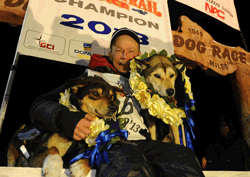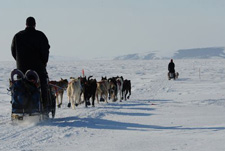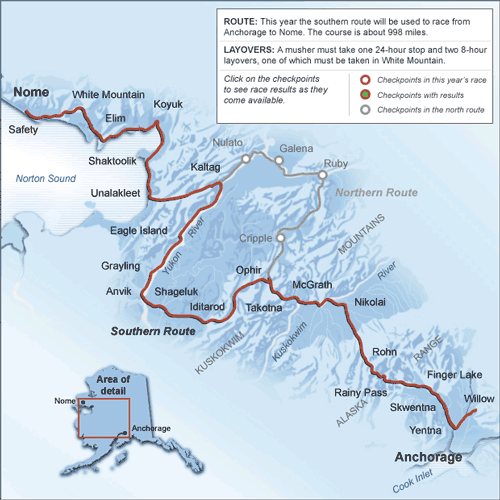Oldest Iditarod winner, 53, follows in son’s footsteps
Daily News Article — Posted on March 14, 2013

Mitch Seavey became the oldest winner, and a two-time Iditarod champion when he drove his dog team under the burled arch in Nome on Tuesday evening, March 12. He sits with his two lead dogs, Tanner, left, and Taurus. (Bill Roth/The Anchorage Daily News via AP)
(by Yereth Rosen, Reuters) ANCHORAGE, Alaska – The 2004 winner of Alaska’s famed 1,000-mile sled-dog race, the Iditarod, won again at age 53 on Tuesday to become the oldest champion, a year after his son became the youngest winner.
Mitch Seavey and his team of dogs sprinted across the finish line just 24 minutes ahead of Aliy Zirkle, who was bidding to become the first woman to win the Iditarod since 1990, when Susan Butcher claimed her fourth championship.
Seavey mushed his way from Anchorage, Alaska’s largest city, to the Bering Sea town of Nome in nine days, seven hours, 39 minutes and 56 seconds, his winning margin one of the narrowest in the event’s 40-year history.
“I just now stopped looking over my shoulder, so I kind of realized we’re here,” Seavey said.
Seavey had been just 13 minutes ahead of Zirkle on Tuesday morning when they departed White Mountain, an Inupiat Eskimo village where racers must stop for 8 hours.
Last year Zirkle finished second to Seavey’s son Dallas, then just 25. Dallas Seavey was on course to come in fourth this year.
The family have a long tradition in mushing. The race was Mitch Seavey’s 20th Iditarod, and his father competed in the inaugural race.
 “I hate to go off into the sunset thinking I only did it once out of 20 or more tries,” said Seavey, who lives in Seward, Alaska, and operates a seasonal sled-dog touring business.
“I hate to go off into the sunset thinking I only did it once out of 20 or more tries,” said Seavey, who lives in Seward, Alaska, and operates a seasonal sled-dog touring business.
This year’s contest was marked by unusual thaw conditions and unseasonable rain in the northern part of the trail, conditions that Seavey said helped his team. “It seems like the tougher it is, the better we can do.”
He also gave credit to Zirkle, a New England transplant who now lives in Two Rivers, Alaska. “She’s a great musher, and she’s going to win the Iditarod sometime, and probably more than once. We just had a little more steam, I think.”
Zirkle, one of the most popular mushers, was greeted by chants of “Aliy, Aliy” from spectators as she drove her dog team into the finish chute on Nome’s Front Street. “I am pretty happy to be here,” she said. “I was going for it.”
The Iditarod Trail Sled Dog Race, which commemorates a 1925 rescue mission that carried diphtheria serum to Nome by sled-dog relay, is one of the few major U.S. sporting events in which men and women compete on an equal footing.
The name “Iditarod” derives from a local Athabascan term meaning “a far, distant place,” according to race officials.
The year’s event started on March 2 with a ceremonial run in Anchorage. Of the 66 mushers who started the race, 10 had dropped out of competition as of Tuesday night.
For his victory, Seavey will take home $50,400 and a new truck.
Reprinted here for educational purposes only. May not be reproduced on other websites without permission from Thomson Reuters. Visit the website at Reuters.com.
Background
The Iditarod Trail Sled Dog Race:
- The Iditarod Trail Sled Dog Race is an annual long-distance sled dog race run in early March from Anchorage to Nome.
- Mushers and a team of 16 dogs, of which at least 6 must be on the towline at the finish line, cover the distance in 9-15 days or more.
- The Iditarod began in 1973 as an event to test the best sled dog mushers and teams but evolved into today's highly competitive race.
- The current fastest winning time record was set in 2011 by John Baker with a time of 8 days, 19 hours, 46 minutes, and 39 seconds.
- Teams frequently race through blizzards causing whiteout conditions, sub-zero temperatures and gale-force winds which can cause the wind chill to reach −100 °F (−73 °C).
- A ceremonial start occurs in the city of Anchorage and is followed by the official restart in Willow, a city in the south central region of the state. The restart was originally in Wasilla, but because of too little snow, the restart was permanently moved to Willow in 2008. The trail runs from Willow up the Rainy Pass of the Alaska Range into the sparsely populated interior, and then along the shore of the Bering Sea, finally reaching Nome in western Alaska.
- The trail is through a harsh landscape of tundra and spruce forests, over hills and mountain passes, and across rivers. While the start in Anchorage is in the middle of a large urban center, most of the route passes through widely separated towns and villages, and small Athabaskan and Inupiat settlements. The Iditarod is regarded as a symbolic link to the early history of the state and is connected to many traditions commemorating the legacy of dog mushing.
- While the yearly field of more than fifty mushers and about a thousand dogs is still largely Alaskan, competitors from fourteen countries have completed the event including the Swiss Martin Buser, who became the first international winner in 1992. (from wikipedia)

